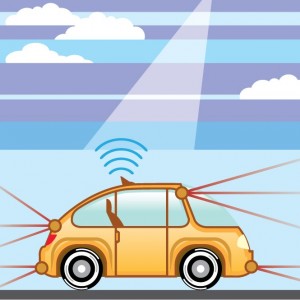Self-driving cars will soon be street-legal, and California is getting a jump on regulating them

Image from Shutterstock.
As any fan of rock ‘n’ roll’s hot rod genre can attest, cars have been an essential element of California culture for more than a century.
So it’s only fitting that California is at the center of the growing movement to give cars, trucks and other motor vehicles the technology to allow them to do more for their owners than just get them from Point A to Point B, regardless of traffic jams. In essence, cars are becoming more than just cars; they’re turning into computers on wheels.
But that reality carries risks as well as rewards, said panelists at a program on Thursday afternoon in, fittingly, San Diego. The program sponsored by the ABA Section of State and Local Government Law was one of the opening events at the midyear meeting, which runs through Monday.
One of the most dramatic—and perhaps even a bit mind-boggling—developments is the auto industry’s efforts to create self-driving vehicles, said Brian Soublet, chief counsel for the California Department of Motor Vehicles. He explained that autonomous—or self-driving—cars are defined by various levels of capability to operate without the active involvement of a driver.
The highest level, Soublet said, is a vehicle that can operate without a driver even being in it. But, he added, “we want to see a driver in the vehicle.”
Soublet predicted that, given the pace at which the necessary technology is being developed, self-driving vehicles are likely to be on the nation’s roadways in three to five years. In some places, however, including San Francisco, self-driving vehicles already are showing up on the streets on a test basis.
Soublet’s department has been developing regulations for self-driving vehicles under a law passed by the state legislature in 2012 mandating that the department conduct assessments of the safety of new technology in cars and other motor vehicles. The department held its most recent public hearing relating to its efforts Tuesday. The department may issue its regulations in about a year, he said.
Among the concerns raised by self-driving cars, as well as other technology being applied to motor vehicles, is whether the auto industry should be allowed to self-certify the safety of these rolling computers—what he termed the “trust me” approach. He noted that the industry has begun pushing for the federal government to get involved in the regulatory process so that it doesn’t have to deal with a byzantine structure of 50 different state regulatory schemes.
Liability issues also are on the horizon, said Soublet. There is bound to be debate over how liability should be allocated when a self-driving vehicle is involved in a collision or other accident that causes personal injuries or property damage, he said. What liability should apply, for instance, when a car reverts suddenly to driver control? He noted that even a gap of a few seconds before the driver takes control can create serious risks, and a car can’t be programmed to just stop on the highway when a collision is imminent.
“It’s fascinating,” said Soublet of the new capabilities that are being created for cars. “It’s also scary technology.”
But even though self-driving vehicles will be in existence within a few years, they won’t be common sights until at least 2025, said Soublet, who noted that Americans tend to hang on to their cars, even older ones. The average age of cars on the road is about 11 years.
• See what people are saying about #ABAMidyear on Twitter, and follow along with our full coverage of the 2016 ABA Midyear Meeting.
• See the full schedule of events. There are mobile apps available for Apple and Android users.



